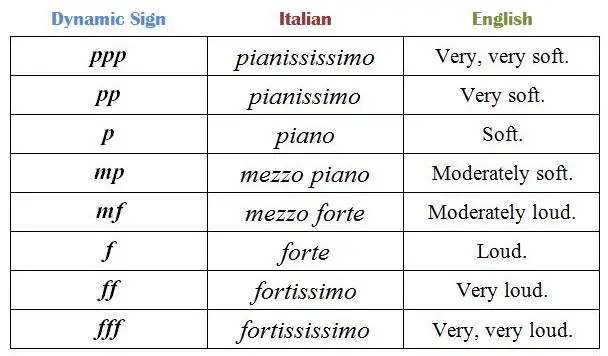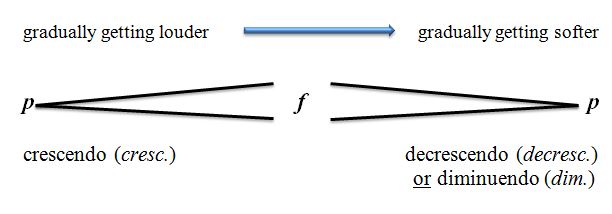What Are Dynamic Signs?
How loud or soft you play music is represented with dynamic signs.
These symbols appear as 1 or 2 letters combined together in your music. Each sign represents a musical term in Italian.
| ✅ The best self-study music theory book loved by all my readers and students. |
Why Italian?
Some of the first composers to write these types of directions were from Italy.
What they first wrote down in manuscripts has been around for centuries.
Everyone basically adopted this as standard notation and we still use it today.
Here are some of our most common dynamics and their meanings:

The first column is the actual sign used in the music.
The next column shows the full Italian music term for each of the symbols in column one.
The last column gives the English translation for the meaning of each Italian term and corresponding marking.
For example, the Italian term piano is indicated with a “p” in your music and it means to play soft.
If you read down column one from top to bottom, the symbols are arranged from softest to loudest.
Interesting Insights
Did you notice how forte and piano are pretty much the basis of what you really need to remember? All of the other words are just variations upon the same thing.
Mezzo means moderately and –issimo means very. So, we now have more ways to describe loud and soft. Interesting…
More Changes
Around the 19th century, composers came up with idea of having gradual changes in volume.
Up until this point, all dynamic differences were pretty sudden. Making alterations in volume gradually was a new and revolutionary idea!
It became it’s own technique and needed it’s own place in the world of dynamics.
So of course, a few new Italian names were created along with some new symbols.
This brand new idea brought about it’s own unique markings in music.
Crescendo’s & Decrescendo’s
A crescendo means to grow louder while a decrescendo or diminuendo means to grow softer.
For a crescendo, you start soft and gradually get louder.

On a decrescendo or diminuendo (they mean the same thing), you do the opposite. Now, you start loud and gradually get softer.
Why Do We Have Dynamics?
In order to make music sound interesting, we need contrast. Playing or singing everything at one volume level is boring…and sometimes annoying.
Our ears and interest levels respond best to variety. A simple dynamic sign can take something mundane and make it beautiful.
Where Did It Come From?
If something is “dynamic”, it is in constant change, in motion having activity, or reaching progress. It is never stagnant.
This gives you an idea on how they probably came up with the name “dynamics” to describe volume changes.
Recommended Music Theory Books
✅ The best self-study music theory book loved by all my readers and students.

If a music sheet simply has the abbreviation cresc., how many measures do you crescendo for?
This is completely up to you as the performer. Musicians are given liberty to interpret the music as they see will be best musically. This is where we step away from exact science and start creating based on the guidelines given to us by the composer. This is the point where we (as musicians) take the written music and make it come alive with our own creative musical interpretation!